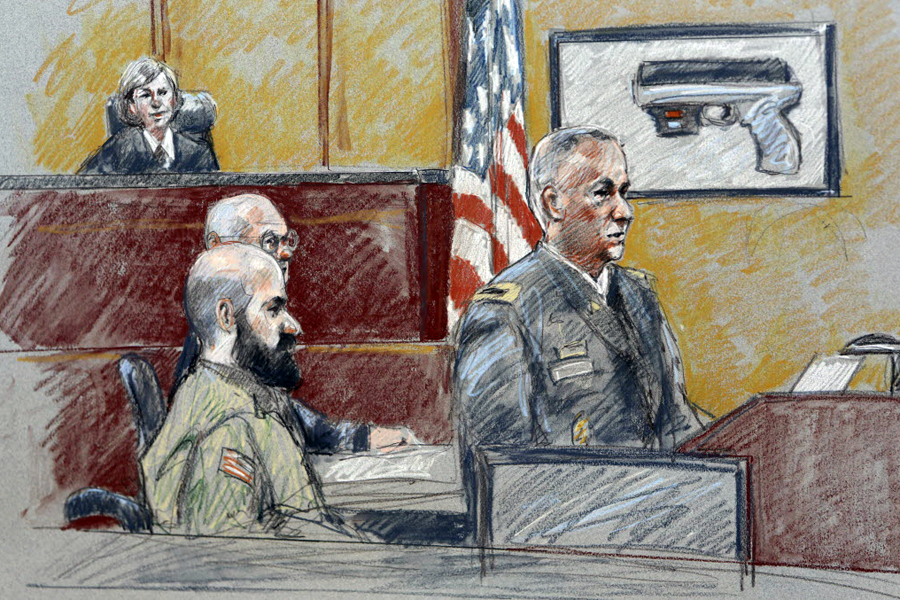Seeking martyrdom, Nidal Hasan raises little fuss in Fort Hood courtroom
Loading...
Maj. Nidal Hasan appears to be stoically slouching toward martyrdom at his court-martial – instead of using the trial as a soapbox to spout jihadist ideology, as have others in a similar position.
Inside a heavily fortified compound at Fort Hood, Texas, a court-martial expected to take months is moving quickly ahead of schedule. The Army psychiatrist, accused of murdering 13 fellow soldiers and injuring more than 30 in an attack on Nov. 5, 2009, has remained cool, collected, and businesslike, even amid riveting and horrific testimony.
To be sure, he could still let loose invective on the courtroom, particularly during closing arguments, terror law experts say. But the bald, bearded Hasan, who is representing himself, has already suggested that he is basically on board with the prosecution’s plan to convict him and sentence him to death: He told the Army after his arrest, according to a report released this week, that he “would still be a martyr” even if the Army executes him.
It has become a core mystery of the court-martial: Is that tactic, in fact, a piece of brilliant reverse psychology doubling as a defense strategy – in other words, will the military jury be inclined to grant Hasan his death wish or instead spitefully order him to the prison at Fort Leavenworth, Kan., for the rest of his life?
So far, the trial has been packed with barely contained emotion as more than 60 witnesses have recounted the attack, often in graphic terms. Hasan, however, has remained unfazed, raising few objections and declining to cross-examine the victims.
Despite an absence of demagoguery, the taut proceedings, terror law experts say, are still giving Americans a valuable glimpse into the mind of a self-described American jihadist, for whom Western norms of justice appear meaningless.
“The fact is, he has used this trial as a platform, even though he hasn’t done any ranting and raving,” says Jeffrey Addicott, director of the Center for Terrorism Law at St. Mary’s University in San Antonio. “Instead, this guy is very cool, very methodical, very collected and rational. He’s not playing mind games. He wants a martyr’s death, and the only [thing] that’s important in his mind is, how does Allah view what I’m doing? His audience is Allah; it’s not any one person.”
On Wednesday, Hasan told the judge, Col. Tara Osborn, that he authorized the release of a psychological report from 2010 where he makes the comment about an Army execution equaling martyrdom.
Military prosecutors have painted Hasan as a jihadi extremist, while the Pentagon has classified the attack as an act of workplace violence. (According to one Pentagon memo, the classification is geared to protect victims, since a government portrayal of Hasan as a terrorist before a trial could be grounds for appeal.)
President Obama this spring acknowledged that Hasan may have been inspired by jihad, but his administration has stopped short of calling him an Islamic terrorist.
Hasan, terror law experts note, has chosen not to pursue defense strategies around what might have caused him to snap at work. Nor has he used his background as a psychiatrist to paint himself as a mentally unstable soldier.
Instead, the Virginia-born Hasan has explained in plain language his reasoning: He “switched sides” and launched the attack to preemptively protect Islamic soldiers in Afghanistan, where many of the soldiers he killed and wounded were set to deploy.
“We’ve got to understand who the enemy is and what motivates him, which is something most of our political leaders refuse to do,” Mr. Addicott says. “At least this trial is an opportunity for [one terrorist] to tell us who he is – a jihadist who doesn’t care about the rule of law and Western concepts of life and freedom, which are hateful to him.”
Paralyzed and in a wheelchair after getting shot during the attack, Hasan has listened to victims recount the death of a pregnant soldier, as well as the last words of a lieutenant colonel, who told rescuers to try to save others.
Occasionally, Hasan takes notes, write Nomaan Merchant and Paul Weber of the Associated Press, who are part of a small press contingent allowed to witness the trial.








